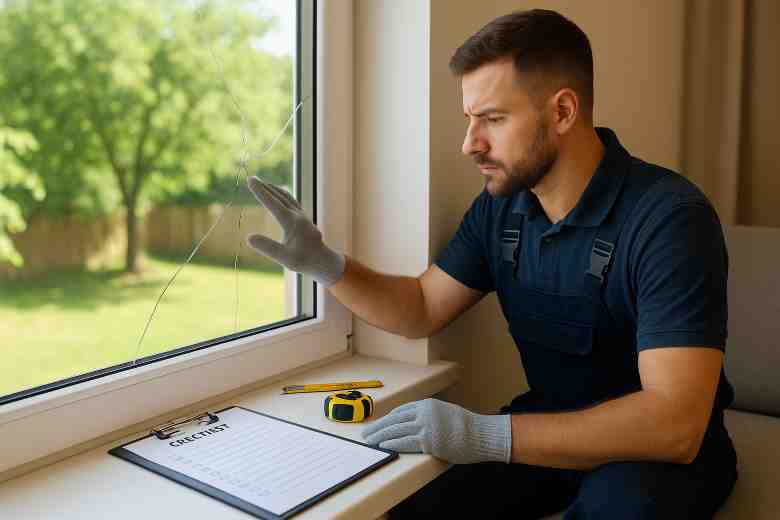Last Updated on June 11, 2025 by Admin
Deciding whether to repair or replace window glass depends largely on the extent of the damage and the age of the window. Minor cracks or chips can often be repaired effectively, saving time and money.
If the damage compromises the window’s insulation or safety, replacement is usually the better option. Ageing windows with multiple issues should also be replaced for improved efficiency and security.
Understanding when to repair and when to replace helps avoid unnecessary costs and maintains the integrity of the home. This article breaks down the key factors influencing that decision.
Table of Contents
Understanding Types of Window Glass Damage
Window glass damage can range from small imperfections to severe breakage, each affecting the window’s functionality and safety differently. Identifying the type of damage helps determine whether repair or replacement is more appropriate.
Cracks Versus Chips
Cracks are lines that extend through the glass, often caused by impact or stress. They can worsen over time due to temperature changes or vibrations, potentially compromising the window’s integrity.
Chips are small, localized losses of glass usually caused by minor impacts, like debris or stones. They often appear as pits or small missing sections on the surface and are less likely to spread if addressed quickly.
Both chips and cracks affect energy efficiency and security. Repairs are usually effective for chips and minor cracks under 15cm. Larger cracks typically require replacement to maintain safety.
Fogging and Moisture Issues
Fogging occurs when moisture gets trapped between double-glazed panes, leading to a misty appearance that obstructs vision. This is usually a sign of seal failure in the glazing unit.
Moisture buildup damages the insulating gas layer and can lead to frame rot or mould. It also reduces the window’s thermal performance, increasing heating and cooling costs.
Fixing fogging often means replacing the sealed unit rather than the whole window. Preventing moisture issues requires durable seals and quality installation to avoid condensation inside the glass.
Broken or Shattered Panes
Broken panes result from strong impacts or accidents and range from small shattered areas to full breakage. They immediately affect security and energy efficiency.
Safety glass, like toughened or laminated glass, holds together when broken, reducing injury risk. Ordinary glass shatters into sharp pieces, requiring complete replacement.
Replacing broken panes restores security and insulation. Temporary boarding or glazing is necessary until repair or replacement is completed, especially in exposed or high-risk areas.
Factors to Consider When Deciding to Repair or Replace
The decision to repair or replace window glass depends on several practical factors. These include the condition of the glass, the overall age of the window, and how well it contributes to energy efficiency and insulation.
Extent of the Damage
Assessing the damage is the first step. Small cracks or chips can often be repaired without replacing the entire pane. Repairs save money and preserve the window’s original frame when possible.
However, if the damage is widespread—such as shattered glass, multiple cracks, or broken seals—replacement is usually necessary. Extensive damage can compromise safety and allow drafts or moisture inside.
A quick checklist to decide repair or replace:
- Minor chip/crack: Repair
- Large cracks or breakage: Replace
- Seal failure (fogging or condensation): Replace
Age of the Window
Older windows may need replacing rather than repairing, especially if they show signs of wear beyond the glass, like warped frames or rotting wood. Repairs might only be a short-term fix.
Modern windows often incorporate better materials and technology. If the window is over 15 years old, replacement might offer long-term benefits such as improved functionality and appearance.
If the structure is intact and the damage is minimal, repairing the glass alone can extend the life of the window without the higher cost of full replacement.
Energy Efficiency and Insulation
Double or triple-glazed windows provide better insulation than single panes. If the glass damage affects such units, replacement is usually the best option to restore energy efficiency.
Repairs rarely match the performance of a whole-pane replacement in reducing heat loss or gain. Broken seals can lead to condensation buildup, decreasing insulation.
When energy savings are a priority, it is important to consider the U-value (thermal transmittance). Windows with damaged glass often have higher U-values, meaning less effective insulation. Replacing glass or the entire window may reduce energy bills.
Cost Implications of Repairing Versus Replacing Window Glass
Repairing window glass often costs less upfront but may require additional expenses later. Replacing glass usually has higher immediate costs but can reduce maintenance and energy bills over time. Insurance policies and warranties also play a role in determining which option is more affordable.
Short-Term Versus Long-Term Costs
Repairs typically range between $100 to $300, depending on damage size and type. This option is economical for minor cracks or chips that do not affect the window’s integrity.
Replacement costs vary widely, generally between $400 and $1,000 per window, depending on glass type and frame. Although more expensive, replacement improves insulation and longevity, potentially saving money on heating and cooling.
Repeated repairs can add up. If damage worsens or the glass is old, replacement often proves more cost-effective by avoiding ongoing expenses.
Insurance and Warranty Considerations
Home insurance policies may cover glass repair or replacement but often require assessment of damage severity and cause. Some policies have excess fees that impact the final out-of-pocket cost.
Warranties on new windows usually cover glass breakage for several years, reducing future repair costs. Repairs on older or out-of-warranty windows rely entirely on homeowner expense.
Confirming coverage details with insurers and window manufacturers helps clarify financial responsibilities before choosing repair or replacement.
Related Posts:
- Why double-glazed windows are better than single-glazed windows
- Safety and Aesthetics: Balancing Function and Style with Glass Railings
- Key Factors To Consider When Choosing Windows
- Balancing Building Aesthetics And Performance Using Windows
- Top-12 Expert Insights on Elevating Your Home with New Windows
- How Transponder Keys Have Become Imperative for Comprehensive Home-Safety


